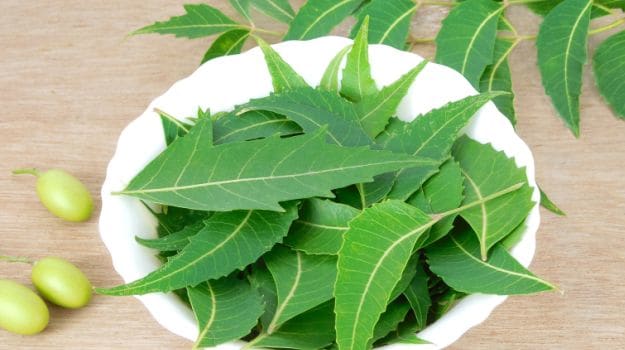Azadirachta indica

Common Names :
English : Indian Lilac, NeemHindi : Neem
Sanskrit : Pakvakrita, Nimbaka
Gujarati : Dhanujhada, Limba
Malayalam : Ariyaveppu
Marathi : Kadu Limba, Nimbay
Tamil : Veppai
Urdu : Neem
Classification
Kingdom
|
Plantae
|
Division
|
Magnoliophyta
|
Order
|
Sapindales
|
Family
|
Meliaceae
|
Genus
|
Azadirachta
|
Species
|
A. indica
|
Distribution and Habitat
It is native to India, Sri Lanka, Burma and Pakistan. It is a fast-growing tree that can reach a height of up to 15-20mtrs. , rarely 35-40mtrs. It is evergreen tree but under climatic conditions like severe drought, it may shed most or nearly all of its leaves. The bark is hard, fissured or scaly and whitish-grey to reddish-brown in colour. The sapwood is greyish-white and the heartwood is reddish when first exposed to the air becoming reddish-brown after exposure. The alternate, pinnate leaves are 20-40cms long with 20-31 medial to dark green leaflets about 3-8cms long. The shape of the matured leaflets is more or less asymmetric, and their margins are serrated. The flowers (white and fragrant) are arranged axillary, normally more or less drooping panicles which are up to 25cms long. An individual flower is approximately 5-6mm long and 8-11mm wide . Fruit is a glabrous olive-like drupe which varries in shape from elongate oval to nearly roundish.
Chemical Constituents
The healing properties of Neem (Indian Lilac) are mainly due to some bitter substances, known as triterpenes (limonoids), with azadirachtin as one of the main active ingredients. Also Neem contains beta-sitosterol, tannins, polysaccharides, flavonoids, and essential oil.The other components include nimbin, nimbinin, and nimbidin. The latter is identified as the primary active antibacterial ingredients and highest yielding bitter components in the Neem oil.
Medicinal Uses
Neem products are known to be antihelmintic, antifungal, antidiabetic, antibacterial, antiviral, contraceptive, and sedative. The oil from the seeds is often mentioned as margosa oil. Neem oil is used for healthy hairs, to improve liver function, detoxify the blood and balance blood sugar level. Neem leaves have been very effective against skin diseases like eczema, psoriasis, etc. The extract has been used internally as treatment for asthma, sore throat, tuberculosis, eczema, jaundice, stomach ulcers, arthritis, and rheumantis. The bark is bitter and has astringent properties, and decoction made from it can be used as remedy for haemorrhoids. Aslo, it is sometimes used to treat hepatitis A and B, and 'mono' or 'the kissing disease' (mononucleosis), caused by the Epstein-Barr virus. Studies have shown that the neem oil does have anti-inflamatory and bactericidal properties and that is at least to some extent, can be used to reduce high fever and high blood sugar.
Source: Medicinal & Aromatic Plants Abstracts ( NISCAIR )
SOME BENEFICIAL PRODUCTS OF NEEM
SOME BENEFICIAL PRODUCTS OF NEEM
- In India -
- In US -







No comments:
Post a Comment